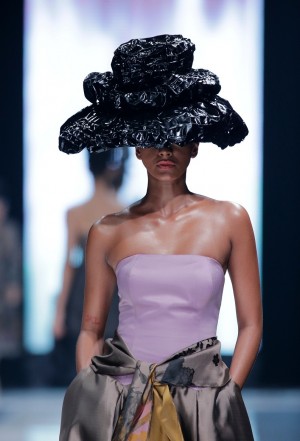Jakarta Fashion Week Rallies for Fabulous Finish Despite Trouble in Paradise
Editor’s Note: The gallery from the show can be found below. Another gallery or two will be added at the end of the piece a little later today. For pictures of the first few days of the Jakarta Fashion Week 2013, please visit our piece on the opening days of the show, published on November 4th.
Fashion’s entire raison d’être is to titillate the imagination, and to that end more “traditional” venues such as Paris and Milan work wonderfully. But their biannual repetitiveness, no matter what the likes of McQueen and Burberry throw at us, lacks certain verve these days; even other European weeks that are a bit more off the beaten path — think Madrid, Stockholm and Vienna — fail to fully stir the senses the way they used to.
But excitement certainly isn’t lacking in Indonesia’s sun-drenched capital. A certain joie de vivre was on full display in this tropical paradise during the sixth annual Jakarta Fashion Week (JFW), even if the weather brought it uncomfortably close to unmitigated disaster.
After an ostensibly precocious debut November 3 from Lie Sang Bong and Sebastian Gunawan that set the bar almost impossibly high, expectations for the rest of the week were understandably ambitious.
Those had to be tempered, however, when a monsoon rolled through and caused an outdoor tent serving as the main venue to collapse twice on November 4 and 5. Several shows — including the much-anticipated the Mysterious Regal by noted designer Ivan Gunawan — had to be rescheduled, causing derision in local media.
But the show did go on — and what a show it was. A total of 59 shows were held throughout JFW, involving 170 designers, 19,000 guests, and about a thousand journalists. With a theme of “Indonesia Today, The World Tomorrow,” an international flair was clearly evident.
“This collection sums up 40 years of my work,” gushed Josephine Komara, also known as Obin, to reporters after showcasing eclectic designs with radiant silks.
One show of particular note was Oscar Lawalata’s. Despite the confusion wrought by the unexpected storm, his show on November 4 was glitzy stopgap that saved the week when events from the ruined tent were moved into a nearby shopping mall — meaning models had to walk across a catwalk an unbelievable four meters high.
“Oh my God, the stage is really high,” explained model Tia Apranti of her feelings about being in the show, where she and 11 others showcased two outfits each from Lawalata’s collection. “We usually walk on the lower part of the stage but we found out this morning that we also have to walk on the higher part — and it has no safety rail.”
Despite this, Lawalata’s collection of clean hemlines, solid prints and plethora of black — a symbol of stability that did not go unnoticed amidst the logistical chaos — was well-received, even with a minor controversy over one of his looks appearing at first glance to be little more than a bed sheet tied imaginatively around a model’s waist.
As the week wore on, a sense of normalcy (at least as much as can be achieved in what has become one of the biggest fashion weeks in Southeast Asia) returned. Yosafat Dwi Kurniawan and Jeffrey Tan were solid with their urban prêt-à-porter collections, while Barli Asmara and Albert Yanuar went for glamorous dresses with a costume-like touch. Dian Pelangi, in a nod to local fashion, showed contemporary designs incorporating the hijab that many Indonesian women use to cover their heads — a smart move, considering Indonesia is the most populous Muslim country on Earth and at least partially governed by Sharia. Yanuar’s dresses were a big hit, as was Cecilia Yuda’s and Lisa Daryono’s massive 48-look, two-sequence show “Billet Doux,” a romantically feminine night gown collection with organdy, lace, and tulle in pastel shades adorned with gemstones, sequins, and pearls — a tropical fairy tale of sorts. The fairy tale certainly became more believable as the show went on; as the soft palettes and platform heels quickly metamorphosed into backless gowns and cuts featuring trains long enough to serve as an airport runway.
If Yuda’s and Daryono’s collection wasn’t epic enough, then JFW’s last show was worthy of a Homeric epic. Inspired by Indonesia’s cultural Heritage, Didiet Maulana presented no less than 62 pieces of womenswear and menswear with “Romantika Mentari,” an ambitious collection as sun-kissed as the beaches of Java. Punctuated by the smooth voice of wafting from an underappreciated sound system, Maulana offered a new take on traditional Indonesian looks with gauzy fabric in red, blue, green, purple, and brown pastels. While the womenswear was complemented by beads and crystal over sheer silk, the menswear offered a more casual vibe, with jackets, pants and shirts also featuring.
And did the resplendent Gunawan get to show? Yes. Was it transformative? — Absolutely.
With a 35-piece collection, the proprietor of no less than separate labels showed off stunning slim silhouettes in neutral palettes of black, beige, gold, and a touch of silver for a feeling of elegant romance worthy of the melancholy ambiance his “Mysterious Regal” theme was intended to convey. Sumptuous gowns were displayed by a parade of models done up to ooze a sense of mystery, with mini dresses, mermaid silhouettes, pagoda shoulder accents, V-necks in sheer fabrics with ruffles and peplum, embroidery and drapery in chiffon, and a breathtaking white wedding gown as a final look from his “Love” label eliciting shrieks of delightful applause. It was a masterful show from one of Indonesian fashion’s true masters.
Sure, JFW may have had its moment of trouble in paradise, but like any good fairy tale it eventually had a happy ending. Henry David Thoreau may have been the first person to insinuate that life’s a beach, but he forgot one important detail: life is a very fashionable beach.
Jakarta Fashion Week: November 7-8


